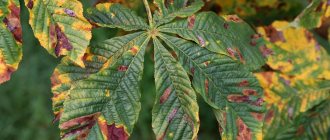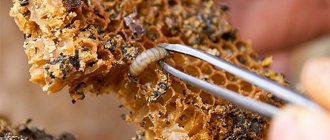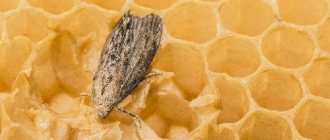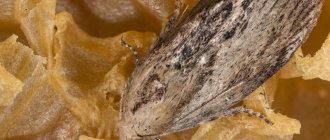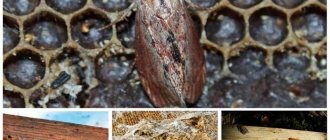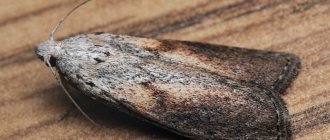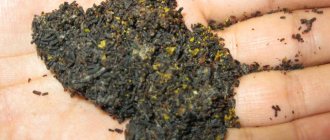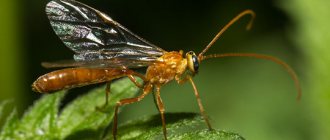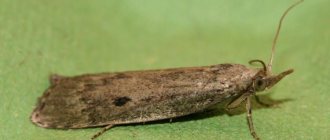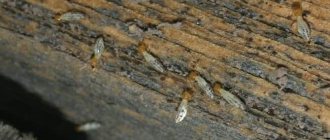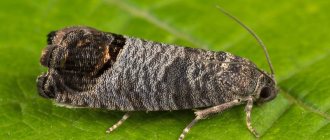Which beekeeper has not witnessed the damage that large and small wax moths cause to the industry? It has been established that the female large wax moth, entering the nest, lays 1500-2000 eggs on the surface of the honeycomb during 26 days of life, from which caterpillars emerge, move to the side wall of the cell, drill a hole in it and on the 4th day reach the middle of the honeycomb , in which exits are made on both sides. The caterpillar's passages are covered with cobweb-like yarn and become invulnerable to bees. An adult caterpillar climbs into a corner, into any crevice of the hive, spins a dense cocoon and turns into a pupa. After 14 days, the pupae enter the butterfly stage.
Bees of strong families drive butterflies out of the hive. For weak families, moths are a dangerous enemy, because each caterpillar consumes 0.4 g of wax for its full development, thereby damaging 500 or more cells. The development of bee colonies severely affected by moths is significantly delayed. Sometimes, due to severe destruction of the nest, bees leave the hive. The pest causes no less harm during storage of honeycombs.
In the apiary, moths are destroyed during routine inspections of bee colonies, and the bottom is periodically cleaned. Moths are removed from honeycombs removed from the hive by lightly tapping the frame. Severely affected honeycombs are removed, the nest is shortened, and it is well insulated, providing the bees with food reserves. When preparing honeycombs that have not been destroyed by moths for storage, they are disinfected.
The moth is destroyed at all stages of its development by keeping the honeycombs at a temperature of -10 °C for 1.5 hours.
Catching moth butterflies
To prevent butterflies from getting into hives or frame storage and laying eggs, it is easier to catch them. To do this, use liter jars filled with 3-4 cm of bread kvass, which are placed on the hives and in places where honeycombs and small frames are stored. The smell of bread kvass attracts butterflies. They fall onto its surface, their wings get wet and they can no longer get out of the jar. In addition to butterflies, no less harmful and annoying flies and midges get into jars.
During honey harvest, bees do not react to kvass and do not get into the jars. During the bee-free period, the jars are covered with plastic lids while the bees are flying. During the first day, from 30 to 70 butterflies end up in each jar. Subsequently, their number decreases. Catching butterflies with little time spent significantly reduces damage from wax moths.
Yu.I.Hupaviy
What kind of insect is this
The wax moth is also often called “shashel”, “motelitsa” or simply “ognevka”. She prefers to settle in places where beekeeping farms are concentrated; in other areas it is extremely rare.
In the environment you can find the so-called large wax moth and small wax moth. The dimensions of the first can reach 35 mm, and the second – do not exceed 24 mm. Representatives of the larger variety are brown or grayish-brown in color, while their more compact counterparts are gray-brown or silver in color.
The wax moth, or moth, in its adult state is not dangerous.
Adults do not have a digestive system, and therefore do not need food. They live off the nutrients accumulated during maturation. Life expectancy is about two weeks.
This insect is quite prolific. One individual is capable of laying about one and a half thousand eggs, from which larvae about a millimeter in size appear a few days later. Due to intensive feeding, they quickly turn into caterpillars up to 3.5 cm long. On the 30th day of its life, the caterpillar is enveloped in a cocoon, from which a new butterfly then emerges.
Acetone against moths
In 4 hive bodies placed on the bottom of the hive, I place 40 dried frames. Many of them were attacked by moths. The upper body was covered and the hole in the ceiling was filled with plywood. I covered all the cracks, and then inserted a sheet of tin with a wall height of 10-12 mm the size of a notebook sheet through the tap hole. First, I put a clean cloth on the piece of paper and poured 100 g of acetone on it. The entrance gap was tightly closed with a plank and covered with plasticine.
On the second day, I removed the ceiling and examined some of the frames in the upper building. There were no longer any living caterpillars. Stopping further review, I covered the upper body again. Two weeks later I removed the ceiling and, when inspecting the frames, did not find a single living caterpillar. The dead caterpillars were black and mummified. This experience gives grounds to recommend acetone as an effective remedy in the fight against wax moths.
P. Batmanov
Treatment
The healing properties of moth were known back in Ancient Egypt. This remedy has long been used to treat tuberculosis, but this is not the only disease that recedes with the use of drugs based on larvae.
For pulmonary tuberculosis
Of course, the greatest results are shown by the use of moth tincture in the treatment of tuberculosis, so we’ll start with that. Of course, when treating tuberculosis, you should not rely entirely on folk remedies, because nothing can replace real medicines. But you are quite capable of helping your body fight this disease. For this purpose, wax moth-based products are used. An alcohol infusion of such a hive inhabitant is a powerful antiviral and antibacterial agent that has a very wide spectrum of action. Due to the presence of enzymes in the drug that destroy the membrane of tuberculosis bacteria and cause an anti-tuberculosis effect. Also, this remedy allows you to heal tuberculosis cavities in the lungs in the shortest possible time. It is recommended to combine the intake of the extract with drug treatment, this will reduce the load of antibiotics on the body and avoid the occurrence of allergic reactions. By the way, moth extract is an excellent prophylactic agent; it strengthens the body and increases its resistance to tuberculosis infection, as a result of which it does not spread throughout the body and does not create new lesions.
For oncology
This insect is also used in the treatment of cancer. Of course, even this wonderful remedy cannot cure cancer, but the use of such tinctures significantly slows down the growth of tumors, has immunostimulating properties, and strengthens the body after chemotherapy for oncology.
During pregnancy
During pregnancy, it is not recommended to take an alcoholic infusion of moth larvae, but an aqueous extract will be just right. The use of this drug helps reduce the manifestations of toxicosis, corrects placental insufficiency, regulates blood rheology and its microcirculation in the body.
For diabetes
If there is a lack of insulin in the body, moth extract helps in the restoration of pancreatic cells. This remedy significantly reduces blood sugar and stimulates the functioning of the entire body as a whole. In combination with other beekeeping products, this is simply an incredible medicine that really helps in the treatment of diabetes.
For prevention
As already mentioned, medicines containing hive inhabitants have high antibacterial and antiviral properties. Daily use of this tincture will strengthen your immunity for a long time, the body will perform its functions better and you will forever forget about visits to doctors. It is always better to prevent a disease than to treat it, so don’t neglect prevention!
For cancer
In addition to the fact that preparations with the addition of wax moth larvae significantly reduce the growth of tumors in the body, they also help restore tissue after surgery. This is the best remedy recommended for use after operations. The larva also allows you to relieve symptoms and complications after chemotherapy and treatment with strong antibiotics.
Use in homeopathy
This remedy is very popular in homeopathy. Of course, many scientific studies have already confirmed the healing properties of such a tincture, but homeopathy came to this much earlier. For example, the famous homeopathic doctor S. A. Mukhin conducted a lot of research on the treatment of tuberculosis with this particular substance.
In gynecology
Extract of parasite larvae in alcohol is very widely used in gynecology and obstetrics. They treat menopausal disorders, miscarriage and infertility (both female and male). It helps fight anemia in pregnant women. It is also effectively used to treat a variety of cysts and uterine fibroids.
For hypertension
Studies show that daily intake of moth extract can reduce blood pressure by 10-15%! (MISSING) just one and a half weeks after the start of the course. You need to take the medicine for three months. Also, tincture of worms helps fight arrhythmia, coronary heart disease and other diseases of the cardiovascular system.
Honeycombs under the mesh
For the last two years, I have been storing spare honeycombs in a box with a fine metal mesh, through the cells of which moths cannot pass. Throughout the autumn-winter period, the box with honeycombs is constantly exposed to the air. I cover it with a roof to protect it from rain, and to prevent water from entering from below, I place it on a stand. Under these conditions, moths do not grow in honeycombs, and mold does not grow. There are several tiers of strips nailed to the inside walls of the box: one for nesting frames, the second for store frames. Honey, sealed in frames, despite the damp weather, is well stored and does not sour.
Prevention measures
It is better to prevent any problem than to deal with its consequences.
Preventive measures will help:
- monitor the cleanliness of the hives;
- as soon as signs of wax moths appear in the hive, you need to start fighting;
- carry out repairs of hives and frames in a timely manner;
- store wax as far as possible from the hives and try to process it immediately;
- Store additional honeycombs in a well-ventilated area and constantly inspect them.
Experienced beekeepers advise planting plants next to the hives that repel wax moths:
- mint;
- marigold;
- Melissa;
- sagebrush.
Moth is afraid of light
I noticed that the moth attacks mainly dark honeycombs, and if the honeycombs are light, then first of all, the places where the honeycombs collide with each other. The moth prefers dark places, avoiding light. We all know how difficult it is for a moth to part with a hive when the nest is opened. If she flies away from the hive, she immediately rushes to a darkened place.
It is enough to hold moth-infested honeycombs for 1-2 minutes in the sun, and all the larvae jump out. One autumn, for the first time, I hung honeycombs outdoors under a canopy, on the north side, at a height of 2.5 meters from the ground. I made L-shaped hooks from aluminum wire, with the help of which I hung the honeycombs under the canopy on the wire stretched there so that they did not touch each other. This way I store them when the cool nights come in the fall and continue to store them in the spring until warm nights set in. All cells are saved.
FAQ
How does treating frames with honey residues with sulfur affect the quality of honey? Especially when selling honey in bulk. Will it pass quality testing?
If you overdo it with the dosage, then there is a chance that sulfur will get into honey and other products. Therefore, it is better to entrust such processing to specialists.
It is recommended to spray vinegar on frames to repel wax moths. But isn't vinegar, with its pungent odor, harmful to bees?
The vinegar evaporates quickly. If you ventilate the frames in the open air before placing them in the hive, there will be no harm.
Fumigation with smoke
In the autumn-winter-spring period, when the nests of bee colonies need to be reduced, excess honeycombs have to be taken from the hives and stored separately in the hives or in special rooms. This is where the wax moth begins its harmful work. I smoked the honeycomb with sulfur. Moths did not breed in them, but the bees were reluctant to accept them. I left it in the hives behind the diaphragm for the winter - the honeycombs became moldy from the humidity. I put freshly picked lemon balm in the hives with honeycombs, sprinkled the honeycombs with dry mint, but the moths still started. I treated the honeycombs with vinegar - the moth died and did not start again. But this method has its own drawback, which cannot be ignored - acetic acid causes the wire in the honeycomb to rust and break. An old beekeeper once told me that in order to keep the honeycombs free from moths, he smoked them with ordinary smoke from a beekeeper's smoker. I immediately took advantage of his experience. In a container lined with tin so that mice would not penetrate into it, he hung several tiers of honeycombs at a distance of 12 mm from each other, like in a beehive, closed it tightly and filled it with smoke through a special hole at the bottom. I keep the chimney burning throughout the day. I repeat this fumigation three times at weekly intervals: in autumn and spring. If moths have already started in the honeycombs, then their caterpillars become inactive from the smoke, stop feeding, and die on the second or third day. The smell of smoke from the honeycombs subsequently disappears, and the bees readily perceive them. It is also interesting that moths no longer lay eggs in smoky honeycombs.
V. Nedbeev
Description of the pest
Wax moth (clump or moth), the most widespread and annoying pest of honey bees, belongs to the moth family, a species of moth-like butterflies. There are large moths with a wingspan of 18-35 mm and small (less common) with a wingspan of 16-24 mm, the color is ash-gray. The pest is found everywhere in areas of developed beekeeping.
Important! Knowing at what temperature the pest dies, you can fight successfully: wax moths die at high (+45°C and above) and low (0°C and below) temperatures in any phase of development.
The life cycle of a pest can be represented as follows:
- Eggs. An adult female can lay up to 1,500 eggs on frames in two weeks of life. The eggs are oval white, 0.35×0.5 mm, development period 5-8 days. Eggs laid in early summer develop into adult insects by autumn, and eggs laid in autumn overwinter in hives.
- Larva. The eggs hatch into small white larvae (1 mm). As the larva develops, its body changes to a darker color and it grows into a caterpillar.
- Caterpillar. The length of the caterpillar of the small wax moth is 13-16 mm, the large one is up to 18 mm, with a brown head and 8 pairs of legs. The caterpillar development cycle is 30 days. Each individual requires 1.5 g of wax to develop, so one caterpillar can destroy 500 or more cells, preferably from old dark honeycombs. Gnawing through the walls, they entangle the passages with cobwebs, which causes the death of the bees' brood. When the hive is heavily infested, cannibalism among the caterpillars is observed.
- Doll. After a month, the caterpillars turn into brown pupae, burrowing into secluded corners (cracks, cracks, folds, or gnawing holes). They pupate in cocoons arranged in groups. The length of the pupa of females is 16 mm, of males - 14 mm. The insect spends 9-14 days in the pupal state.
- Butterfly. Adult (imago) female butterflies live 7-12 days, male butterflies - 10-26 days. Butterflies have underdeveloped oral cavities and digestive tracts, so insects do not feed during this developmental phase. The wax moth flies from May to September, being nocturnal.
- In one year, 2-5 generations of pests grow. Only moth eggs and pupae overwinter.
Wax moth caterpillars feed mainly on wax and cause significant damage:
- honeycomb;
- bee brood;
- reserves of beebread and honey;
- frames;
- insulation of hives.
It is better not to store old and poorly built frames, but to melt the wax. The pest practically does not attack foundation and light frames. Honeycombs damaged by moths become unsuitable for storing beebread and honey, and bees are deprived of places for brood. With their excrement and waste, moths make the air in the hive unsuitable, and the bees leave the hive.
Did you know? Moth caterpillars can recycle plastic bags without harming their vital functions: in 6 hours, 50 caterpillars can eat 50 mg of plastic.
Strong bee colonies are able to cope with a pest invasion on their own. Working bees clean the cells, destroy the larvae, gnawing them out of damaged honeycombs, and do not allow adult insects into the hive. When a pupa is found, the bee seals it with propolis, and as a result the pupa dies.
But in some cases, human help is necessary, since with the onset of darkness the fires become more active and the bees stop fighting. Unlike bees, wasps do not produce wax. The building material for honeycombs is recycled wood fibers or clay. For this reason, the wax moth has nothing to feed on in the wasp's nest.
Vinegar helped
An accident helped me get rid of wax moths. There weren't enough dry frames, so I decided to wash the old brown honeycombs. I took a large tank, poured three buckets of warm water into it, added 0.5 liters of vinegar and soaked the honeycombs in this solution. Having treated the frames in this way, I placed them in the hives, and left the solution in the apiary. How surprised I was when I discovered many dead wax moths in the tank. The vinegar solution turned out to be a good bait for them. Now I have no problems with wax moths.
A.S. Solovyov
Damage caused
The adults of moths and moths are harmless, because their mouthparts and digestive organs are not developed. And voracious caterpillars are capable of causing catastrophic damage to an apiary, destroying honeycombs and driving individual bee families out of the hives. Developing pests feed on everything that is in the immediate vicinity:
- honey;
- beebread;
- honeycomb wax;
- pollen;
- royal jelly;
- propolis;
- remains of bee brood;
- insulation;
- the material from which the frames are made.
When infested on a large scale, moth larvae are capable of eating their weaker counterparts and the droppings left by previous generations of parasites.
Along the way of their movement inside the hives, the caterpillars gnaw out numerous tunnels, pollute the internal space with excrement, seal the honeycombs with silk cobwebs, turn the contents of the bee house into dust, and damage the brood. One larva from the day it emerges from the egg until the moment of pupation can destroy up to 500 honeycomb cells. The consequences of wax moth infection can be sad: honey bees weaken, cannot withstand such proximity and leave their hives, and in advanced cases die.
Polyethylene will protect against moths
Honey collection largely depends on the preservation of honeycombs - the “golden fund” of the apiary. Over the course of 5 years I have tested different ways to store them. The following method turned out to be reliable. After pumping out the honey, I immediately place the honeycombs that will be stored in a prepared, clean case. The housings with honeycombs (I keep bees in multi-hull hives) are placed in prepared plastic bags and tied. I take the prepared packages into storage. With this storage method and control check after 1-2 weeks, there are no wax moth larvae. Honeycombs are perfectly preserved for a long time and are always ready for use.
Before installing them in the hive, I lightly sprinkle them with warm water and give them to the bees mixed with wax. I expand the nest with the whole body at once. I also install store extensions. The bees master the honeycomb and quickly remove the foundation.
V.A.Eskiy
How to prevent caterpillars from appearing?
Preventative measures to avoid infestation of hives with wax moths:
- maintaining cleanliness in the honeycomb storage, beehives, and the apiary in general;
- regular inspection of hives;
- maintaining optimal temperature in the storage, regular ventilation;
- destruction of heavily damaged honeycombs;
- planting plants around the hives that repel moths (geranium, mint, lavender, marigolds).
Lavender
Small grooves are dug between the hives and filled with water. This helps prevent larvae from moving from one hive to another.
Traditional methods
To fight moths, I use proven folk remedies - mint, oregano, wormwood, walnut leaves. At the bottom of the box in which the dry food is stored, lay a layer of fresh green stems of these plants, install the frames tightly, and also place the stems on top of them. For 5 years there were no moths in the boxes, although some boxes were not opened for two years. By the way, oregano or mint, placed around beehives or under honey frames in boxes, reliably repel ants.
S. Kuzminsky
Facilities
The market offers a wide range of products, various chemicals against larvae: folk remedies, acetic and formic acid, special preparations and much more.
Folk
The method of fighting with folk remedies, as a rule, is less effective compared to chemical preparations for moths in the field of beekeeping. However, they are widely available and harmless to honey bees.
Plants widely used: mint, hops, garlic, wormwood, thyme, black root, lemon balm. The integrated use of a set of plants enhances the effect. They can be placed near the hives, placed on top of frames or next to the hay storage. The insect also does not tolerate the smell of printing ink, so it is recommended to add fresh newspapers or magazines.
Sometimes you can make a saline solution, which is used less often in practice. The honeycombs freed from honey should be dried and treated with a solution. After drying, the formed sediment should be removed. Before installing honeycombs into hives, you should rinse them with water.
Also used are peculiar traps in the form of honey water with the addition of yeast. An adult individual falls into the water and dies, which reduces the likelihood of infection of the apiary.
Formic acid
Formic acid vapor instantly kills eggs and larvae. The larva, due to the fact that it is in a cocoon, is more stable, so longer exposure to vapor is required. For the same reason, bee honeycombs are treated immediately after removal from the colony to prevent the release of larvae.
For treatment, you need to spray the hive with 14 ml of formic acid, then cover it for 3-5 days immediately and after another 10 days.
Sulphur dioxide
The use of sulfur dioxide is an effective way to combat larvae. It is a highly volatile, fat-insoluble gas and therefore poses no significant risk to bees, wax or honey. It is heavier than air, so it easily settles in the frames being processed.
This control method should begin by placing the affected frames in a separate box. Place a source of sulfur gas under the frames. These may be special strips that need to be held over the burner. After this, close the box. The procedure is recommended every 4 weeks. It also helps eliminate mold from the hive.
Before fighting wax moth larvae in hives, you need to familiarize yourself with safety measures, because sulfur dioxide is poisonous to humans.
Vinegar
80% acetic acid, which can be used regularly as a pest control agent, will control the larvae population to a certain extent. However, there is uncertainty regarding the susceptibility of eggs and pupae. Effective control of it depends on the concentration of acetic acid, the volume used, the effectiveness of sealing the hive, and the period of time during which the honeycombs are exposed to the vapor.
The required 80% acetic acid is a dangerous and aggressive corrosive substance that poses a hazard during storage and use. It is also important to remember that the metal components of the hive can be subject to corrosion, so prolonged exposure to vinegar is not recommended.
To treat affected honeycomb frames, place them in an empty hive. Place a container with 200 ml of 70-80% vinegar solution under the frames. The procedure lasts for 3 days, after 10 days it must be repeated. Before installing the frames, it is necessary to ventilate them. It is more effective to combat it in a cell storage facility. Before you start fighting moths in your apiary, it is recommended that you familiarize yourself with safety precautions.
Askomolin
Ascomolin is a drug that allows you to destroy the insect without significant harm to the health of the bees. The affected honeycombs are placed in the hive, 10 tablets are placed on each frame. The use of ascomolin as a way to combat moths in the hive is recommended by beekeepers.
Antimol
Another insect repellent in beekeeping is anti-moth, which is a universal remedy for repelling adult insects. On the inside of the hive, it is necessary to place a product that emits an unpleasant odor that repels imagoes.
Biosafe
Biosafe is a biological preparation containing Bacillus thuringiensis, a bacteria dangerous to the larvae. For processing, prepare a suspension and spray 25 ml per frame, so for 10 frames you need to prepare 250 ml, for 50 frames - 1250 ml.
Bacillus treatment, as a way to remove moths from a hive, is an excellent example of exterminating pests without affecting the bees.
Walnut leaves
For many years I have been storing wax moth dry as follows. In August-September, I collect walnut leaves from the tree, dry them well, and when I start putting the honeycombs in a chest for winter storage, I sprinkle them with these leaves. I also use hops. When it is ripe, I collect it in the forest, dry it and pour it into frames. The honeycombs were never damaged. Many local beekeepers took my advice and always thanked me.
I.M.Makogin
Treatment
Application of bee moth tincture
Bee moth, the medicinal properties of which have been known to people for a long time, began to be used for preparing infusions. In ancient times, fire was used to treat many diseases. Today the product is also popular. Its use has shown effectiveness in the following diseases:
- Tuberculosis. You should not rely entirely on treatment with folk remedies. But a person can help the body fight this disease. An alcohol infusion based on wax moth is a strong antibacterial agent with a wide spectrum of action. Due to the presence of substances such as enzymes in the drug, the shell of tuberculosis bacteria is destroyed. It is recommended to combine the tincture with drug treatment. This will help avoid possible allergic reactions and reduce the load of antibiotics on the body. The extract is also a useful prophylactic, it has a strengthening effect on the body, it resists infection and prevents its further spread.
- Oncology. Treatment of oncological diseases with bee moths does not give 100% results. But the use of a tincture with immunostimulating properties slows down tumor growth and helps strengthen the general condition of the body after undergoing chemotherapy.
- Pregnancy. During pregnancy, you should take an aqueous solution of bee moth. It helps reduce the reaction of toxicosis, helps regulate viscosity, blood fluidity, and correct placental insufficiency.
- Diabetes. The use of bee moth tincture restores pancreatic cells, reduces blood sugar levels, having a beneficial effect on the general condition of the body. If you combine it with other beekeeping products, you get a really good remedy that helps in the fight against diabetes.
- Hypertension. If you take moth tincture for one and a half weeks, blood pressure decreases by 10-15%. The course of treatment lasts 3 months. The medicine helps well with coronary heart disease and arrhythmia.
- Gynecology. An extract based on bee moths is used in obstetrics and gynecology. With its help, women are treated for infertility, menopausal disorders, fibroids and uterine tumors.
- Treatment of cancer with drugs containing bee moth larvae significantly contributes to reducing the growth of tumors in the human body, tissue restoration after surgery, relieving complications after chemotherapy, and the use of strong antibiotics.
- Prevention. With daily use of the moth, the immune system is strengthened and the general condition of the body improves. It is enough to drink 20 drops of tincture daily for three months.
Use of moth extract by doctors
Homeopathic doctors have long used moth tincture for the treatment and prevention of various diseases. Famous homeopath S.A. Mukhin conducted many studies that confirmed the effectiveness of the tincture in the treatment of tuberculosis.
In folk medicine, bee moths are also used to treat children. The drug is used for preventive purposes, it treats bronchitis, pneumonia, and is used to improve immunity. Take the tincture one drop at a time depending on age. A seven year old child should be given 7 drops per day. The drug is taken for a week, after which a break is taken for 1 month. If necessary, the course of treatment is repeated.
Peppermint
Knowing that mint tincture is sprinkled on bees during the union of families, it is harmless to bees, but wax moths are afraid of it, I added 30 drops of mint tincture to 50 g of water, lifted the floorboards on both sides of the nest and gradually poured the solution between the frames. I did this in the evening, when the bees stopped flying. On the 2nd day I examined the bees - they behaved calmly, all the larvae fell off, the bees worked together. A week later, the larvae appeared again - I re-treated the bees, and the result was also positive.
Storage space for honeycomb frames
The place for storing frames should be dry, with a humidity of 70-80%, ventilated, and free of foreign odors. High humidity causes liquefaction of honey and, as a result, its fermentation and souring, honeycombs become moldy and rot, and those containing beebread will have to be discarded later. You can store honeycombs with beebread only by first filling them with honey, thick sugar syrup with the addition of vinegar essence, or covering them with powdered sugar. You cannot store honeycombs with beebread in the cold, as it loses its biological value. Bees on frozen bee bread in early spring raise significantly less brood. Optimal conditions for its storage are achieved at a temperature of +5-10 °C.
Garlic against moths
Garlic is a good repellent and disinfectant. It is placed in flour and wheat against flour mites. Since ancient times, people have used garlic to disinfect the intestines, etc. This gave me the idea to use garlic against moths. In the fall, when sorting honeycombs before collecting them for long-term storage, I carefully clean the bars and frame strips of propolis and wax and lightly rub them with garlic. The bodies and free hives that I use to store honeycombs are also cleaned from the inside and rubbed with garlic.
In the spring, with the onset of warmth, I put a little finely chopped garlic in the frame storage on the racks and in the housing with honeycombs. I also place one clove of garlic, cut into three parts, on the insulation sheet in each hive. The results are excellent every time: there are no moths in the apiary, the bees are always healthy, the colonies grow well and are always highly productive. Costs are low. For 100 bee colonies, 30 heads of garlic are spent per season.
Literature
- Bakaneva, Valentina Fedorovna. 2002. [www.dissercat.com/content/biologicheski-aktivnye-veshchestva-iz-lichinok-galleria-mellonella-i-produktov-zhiznedeyatel “Biologically active substances from Galleria mellonella
and bee waste products as potential cardioprotectors and adaptogens under the influence of hypodynamic and stress factors on the body of experimental animals and humans.”] Dissertation. for the job application Art. candidate of biological sciences. - Moscow. Institute of Cell Biophysics RAS. 2002 - 76 p. - Glupov V.V., Khvoshchevskaya M.F., Shchepetkin I.A., Kryukova N.A. 1997. Morphofunctional structure of the hemocyte population of Galleria mellonella L. (Lepidoptera: Pyralidae) during the infectious process // Izv. AN. Ser. biol. - 1997. - No. 6. - P. 645-653.
- Dubovsky, Ivan Mikhailovich. 2004. [www.dissercat.com/content/antioksidantnaya-sistema-kishechnika-lichinok-galleria-mellonella-l-pri-bakterioze-i-vozdeis “Antioxidant system of the intestines of Galleria mellonella L. larvae during bacteriosis and exposure to secondary plant metabolites.” ] Dissertation. for the job application Art. candidate of biological sciences. - Novosibirsk. Institute of Systematics and Ecology of Animals SB RAS. 2004 - 139 p.
- Kuznetsova Yu. I. 1981. Goals and methods of breeding wax moth (Galleria mellonella L.). In the book. Mass breeding of insects. - Kishinev, 1981. - P. 26-30.
- Lozinskaya, Yana Leonidovna. 2002. [www.dissercat.com/content/izmenenie-aktivnosti-detoksitsiruyushchikh-fermentov-i-antioksidantnogo-statusa-lichinok-gal “Changes in the activity of detoxifying enzymes and antioxidant status of Galleria mellonella L. larvae with microsporidiosis.”] Dissertation. for the job application Art. candidate of biological sciences. - Novosibirsk. Institute of Systematics and Ecology of Animals SB RAS. 2002 - 129 p.
- Serebrov V.V., Alekseev A.A., Glupov V.V. 2001. Changes in the activity and spectrum of hemolymph esterases of the wax moth caterpillars Galleria mellonella L. (Lepidoptera: Pyralidae) during mycoses // Izv. AN. Ser. biol. 2001. - No. 5. - P. 588-592.
- Dudziak B., Jozwik Z., Paszewski A. Experiments on the activity of several extracts from the larvae of Galleria mellonella L. On Mycobacterium tuberculosis 607. // Ann. Univ. M. Curie Sklodowska, 1962, - v. 17, - No. 14C, - p. 454-461.
- Hink WF, Briggs JB Bactericidal factors in haemolymph from normal and immune wax moth larvae, Galleria mellonella. // J. Insect. Physiol, 1968, - v. 14, - p. 1025—1034.
- Hoffmann D., Hultmark D., Boman HG 1981. Insect immunity: Galleria mellonella and other Lppidoptera have cecropia-P9-like factors active against gram negative bacteria. // Insect. Biochem., 1981, - v. 11, - p. 537-548.
- Olivier HR Antibiotic action of an extract of Galleria mellonella. // Nature, 1947, - v. 159, - No. 4046, - p. 685.
